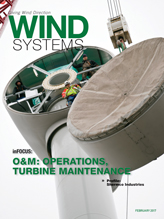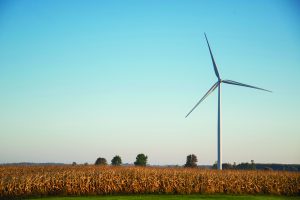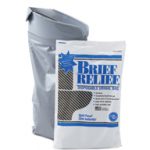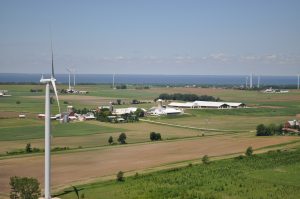Wind turbines continue to get bigger. The downside is that as they get bigger, they also get heavier.
But promising research being done at American University in Washington, D.C., is finding the world of plants may hold the answer in not only making turbine pieces lighter, but also using a renewable resource to accomplish that goal.
It’s called nanocellulose.
“Nanocellulose is simply cellulose fibers that have a width scale that’s typically 20 nanometers or smaller,” said Douglas Fox, associate professor of the Department of Chemistry at American University.
Nanocellulose is typically divided into two types: nanofiber and a nanocrystal.
“The nanofiber can be very long,” Fox said. “It can be upwards of several microns and perhaps even longer than that, whereas the nanocrystals are typically no longer than 100 to 200 nanometers. The difference between the two is that the crystal tends to have slightly higher crystallinity because if you hydrolyze the nanofiber, then you can get these slightly more crystalline types of entities. So you either have longer, which are better to bridge crack propagation, or you have shorter ones that are stiffer. Depending on what your application is, you choose one or the other.”
Wind Application
For the wind industry, that application would mean replacing the filler used in turbine blades, making them lighter.
“In wind, the wind-turbine blades right now are made from epoxy composites,” Fox said. “And they are primarily glass filled. And the problem is, as you start to get to longer and longer blades, it gets more difficult to use glass. You’re starting to find a limit simply because of the weight of the glass. There has been some experimenting into combining carbon fibers in place of the glass fibers and again that is certainly where you would find using cellulose as a viable alternative to the carbon.”
The nanocellulose is lighter and also comes from a renewable resource, so it becomes more environmentally friendly as well, according to Fox.
“Glass is quite heavy,” he said. “So when you put it into plastics, you’re adding weight to the material. Cellulose is very light. It has the lowest density of those type materials. And it ends up having higher strength as well than the glass, especially when you do it on a per weight basis.”
Carbon Alternative
Nanocellulose is a viable alternative to carbon, too.
“One of the things that is potentially improved by going to cellulose from carbon is that you can improve toughness in addition to tensile strength, all while reducing the weight of the composite” Fox said. “Another advantage for cellulose over carbon is that nanocellulose, depending on how you make it, could reduce some of the processing. Some reports show that cellulose is cheaper than carbon.”
However, Fox cautions that as of now, the cost factor is difficult to judge.
“There’s work on the way to try and increase production as more and more applications are becoming available,” Fox said. “But the smaller production size makes it kind of hard to judge cost between them at this time. The materials are very comparable in strength and in stiffness, and cellulose is a renewable resource, whereas carbon, most of the time, is coming initially from a petroleum-based polymer.”
Challenges
However, the new technology is not without its challenges. Cellulose has a tendency to aggregate, especially when it’s dry, Fox said.
“So once you dry it you want to be able to redisperse it,” he said.
Cellulose is hydrophilic, whereas most polymers are hydrophobic.
“So you have an interfacial problem where you’re trying to maximize the interaction between two materials that are principally dissimilar,” Fox said.
In some applications, the way cellulose is made with acid lowers its thermal stability.
“So you do have a temperature limitation on it,” Fox said. “It won’t affect most epoxy systems; however, ones that have higher curing temperatures or things that are thermal plastics, you have to worry about degradation.”
And the primary challenge is actually the water absorption, according to Fox.
“Cellulose really likes water, creating a problem in composites, especially outdoors where you might have freeze/thaw situations,” he said. “And the work we’re doing is addressing those problems. We’ve developed a method that simultaneously addresses all of them. Initial results are encouraging, showing improvement in all four properties.”
Nanocellulose already is being used in some applications, according to Fox. Most notably is its use in curing cement, speeding up the process and increasing early strength.
Other applications are probably five to 10 years away, he said.
In the interim, the advantages of nanocellulose will need to be expressed to an industry accustomed to working with glass and carbon.
“You have to show that it’s a viable alternative,” Fox said. “You have to show that it can perform as well, or the industry is not going to embrace it. Alternatively, the driver to keep industry interested in it is that it’s a renewable resource. It can potentially be cheaper, because it is renewable. And, it’s lighter, and that can reduce operating costs.”
Other Uses
Making lighter wind turbines is not the only potential use for nanocellulose. Fox said many industries possibly could get a boost from this field.
“Cellulose is a very good oxygen barrier in most plastics,” he said. “You could potentially reduce the cost in packaging. Right now if you want a good oxygen barrier, you have to use multi-layer film processing where you’re using a very expensive polymer as your oxygen-blocking material.”
Cellulose is also nontoxic, so it could be used in relation to food-type products.
Research also is being done using cellulose in medical implants, according to Fox.
“I’ve used cellulose as flame retardants,” Fox said. “You do have to modify it in some way, but it doesn’t burn as quickly as plastic. You can modify it to enhance that capability.”
The nanofiber is also being used in the paper industry.
“One of the reasons why is because a very small addition of nanofiber increases the strength of the paper,” Fox said.
Polymer Composites
Fox started working with polymer composites after college, specifically working with clay to reduce the flammability of plastics.
“Since I always had an interest in the environment, my projects always revolve around sustainability,” Fox said. “I read several articles on cellulose being a good charring agent, so I started working with cellulose as a flame retardant. I’ve used other plant materials as well as I’ve gone along. Again, I’m trying to keep with natural products to reduce the flammability of polymers. As I was considering other materials, one of the things that came to mind is that carbon nanotubes are very good flame retardants. So I wanted to investigate the use of cellulose nanocrystals, which are similar in size, but sustainable alternatives. It turns out that, on their own, they are not that good as flame retardants, but it did lead into looking at nanocrystals in polymers for other applications. So … that’s kind of where it had its genesis.”
NIST Collaboration
Fox credits a good collaboration with the National Institute of Standards and Technology (NIST) that has enabled a lot of the nanocellulose research to get accomplished.
“The collaborations with NIST are very good for bridging research with commercial applications. Part of their mission is to promote U.S. industries because it’s part of the Department of Commerce,” Fox said. “And the collaborations with leading scientists at NIST are a large part of what’s moved this research forward.”
And Fox said that research has made significant improvement toward addressing issues that have hindered the use of cellulose nanocrystals in wind turbines in the past.
“In my lab, and in other research groups using different approaches, we are all moving toward addressing the commercialization barriers so it can be used in polymer composites, such as those found in automobiles and wind-turbine blades,” Fox said.








































